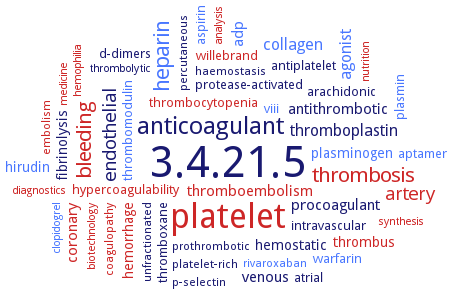3.4.21.5: thrombin
This is an abbreviated version!
For detailed information about thrombin, go to the full flat file.

Word Map on EC 3.4.21.5 
-
3.4.21.5
-
platelet
-
anticoagulant
-
heparin
-
thrombosis
-
bleeding
-
endothelial
-
artery
-
thromboplastin
-
collagen
-
agonist
-
thromboembolism
-
coronary
-
procoagulant
-
adp
-
antithrombotic
-
venous
-
fibrinolysis
-
thrombus
-
hemorrhage
-
hemostatic
-
hirudin
-
plasminogen
-
antiplatelet
-
thrombomodulin
-
protease-activated
-
arachidonic
-
plasmin
-
thromboxane
-
intravascular
-
viii
-
d-dimers
-
atrial
-
thrombocytopenia
-
aspirin
-
aptamer
-
hypercoagulability
-
willebrand
-
warfarin
-
percutaneous
-
p-selectin
-
rivaroxaban
-
platelet-rich
-
unfractionated
-
coagulopathy
-
prothrombotic
-
embolism
-
haemostasis
-
diagnostics
-
analysis
-
hemophilia
-
biotechnology
-
thrombolytic
-
nutrition
-
synthesis
-
clopidogrel
-
medicine
- 3.4.21.5
- platelet
-
anticoagulant
- heparin
- thrombosis
- bleeding
- endothelial
- artery
- thromboplastin
- collagen
- agonist
- thromboembolism
- coronary
-
procoagulant
- adp
-
antithrombotic
- venous
-
fibrinolysis
- thrombus
- hemorrhage
-
hemostatic
- hirudin
- plasminogen
-
antiplatelet
- thrombomodulin
-
protease-activated
-
arachidonic
- plasmin
-
thromboxane
-
intravascular
- viii
-
d-dimers
- atrial
- thrombocytopenia
- aspirin
- aptamer
- hypercoagulability
- willebrand
- warfarin
-
percutaneous
-
p-selectin
- rivaroxaban
-
platelet-rich
-
unfractionated
- coagulopathy
-
prothrombotic
- embolism
-
haemostasis
- diagnostics
- analysis
- hemophilia
- biotechnology
-
thrombolytic
- nutrition
- synthesis
- clopidogrel
- medicine
Reaction
selective cleavage of Arg-/-Gly bonds in fibrinogen to form fibrin and release fibrinopeptides A and B =
Synonyms
activated factor II, alpha-thrombin, alphaTh, beta-thrombin, blood-coagulation factor II, activated, blood-coagulation factor IIa, clotting factor IIa, EC 3.4.4.13, factor IIa, fibrinogenase, thrombase, thrombin, E, thrombin-C, thrombofort, TLE2, topical, tropostasin
ECTree
Advanced search results
Metals Ions
Metals Ions on EC 3.4.21.5 - thrombin
Please wait a moment until all data is loaded. This message will disappear when all data is loaded.
Ca2+
K+
Na+
additional information
K+
-
two ion binding sites per enzyme molecule, binding structure, molecular basis of monovalent cation selectivity, overview, the K+-bound enzyme form shows key differences compared with the Na+-bound structure resulting in different kinetics of activation, overview
Na+
-
kinetic mechanism of Na+ binding to thrombin, stopped-flow measurements of intrinsic fluorescence, two-step mechanism with a rapid phase occurring within the dead time of the spectrometer followed by a single-exponential slow phase whose kobs decreases hyperbolically with increasing Na+ concentration, overview
Na+
-
the activating effect of Na+ on thrombin is allosteric and depends on the conformational transition from a low activity Na+-free, slow form to a high activity Na+-bound, fast form, overview, the Na+-free enzyme is in inactive conformation, Trp215, Arg187, and Arg221are involved, Na+ binding kinetics of wild-type and mutant enzymes, overview
Na+
-
two ion binding sites per enzyme molecule, free thrombin is a Na+-selective enzyme, the K+-bound enzyme form shows key differences compared with the Na+-bound structure resulting in different kinetics of activation, binding structure, overview
Na+
-
two-step mechanism of Na+ binding to thrombin resolved by ultra-rapid kinetics
Na+
-
Na+ activates thrombin by securing the correct orientation of the Glu192-Gly193 peptide bond, which is likely flipped in the absence of cation
-
mutants show reduced specificity for monovalent cations compared to the wild-type enzyme
additional information
-
the cation-free enzyme form assumes a conformation where the monovalent cation binding site is completely disordered, the S1 pocket is inaccessible to substrate and binding to exosite I is compromised by an unprecedented shift in the position of the autolysis loop


 results (
results ( results (
results ( top
top






